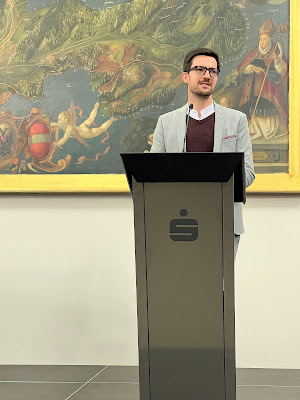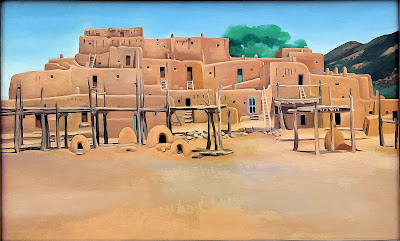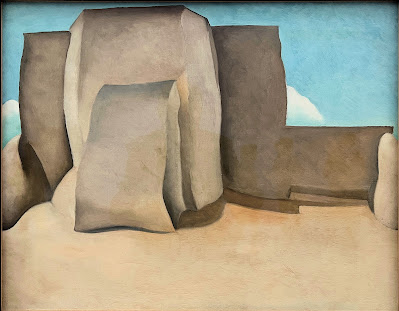Well, not in total; my Gehwerkzeuge (legs) no longer fit for
long distances.

|
|
Sitting on a bench, waiting for the walkers to arrive, and looking at the field of the 1848 skirmish |

|
| An information board gives a brief outline of the events on Easter Sunday, 1848 |
On May 16, 2021, a bot, the MalnadachBot, performed the translation of the German article into English, upgrading the "skirmish" into a "battle. Judge whether the encounter between government troops and a few rushing ahead revolutionaries should be called a battle.
Red Baron also took part in the inauguration ceremony of the memorial for the fallen Freischärler at the Jägerbrunnen (Hunter's Well) at the site of the 1848 skirmish on Easter Monday (April 21) of 2003. My photo of the memorial stone I took on that date garnishes both the German and the English Wikipedia articles.

|
|
Ten years later, the memorial stone is slightly mossy and keep the face of the bard in your memory. |
Back to the 2022 commemoration walk from Horben to Günterstal.

|
|
Eventually, the walkers from Horben arrived and stood around a bit lost. |
At the end of the short commemoration at the monument to the fallen
revolutionaries, the assembled people sang, accompanied by the bard of 2013,
"Thoughts are Free," a familiar song that originated shortly before 1800
in southern Germany.
Its
basic philosophy is already known from ancient times. In the
German-speaking world, Walther von der Vogelweide wrote around 1200: Joch
sint iedoch gedanke frî (Yet thoughts are free).
About 200 years later, Martin Luther wrote in his book: Von weltlicher Oberigkeit, wie man ihr Gehorsam schuldig sei: Thoughts are duty-free!
In his play The Tempest of 1622, Shakespeare has the magician Stephano say in the second scene of the third act: Thought is free.
This view continues into the late years of absolutism. Influenced by the intellectual and social reform movements in Western and Central Europe, Friedrich Schiller had the Marquis of Posa demand of the absolutist King Philip of Spain in his play Don Carlos in 1787, even before the French Revolution: Sire, give freedom of thought!
Since the days of the Carlsbad Decrees and the Age of Metternich, "Die Gedanken sind frei" became a popular protest song against political repression and censorship, especially among the banned Burschenschaften (student fraternities). At the Hambach Fest in 1832, the text is sung against the Carlsbad Resolutions* and the ensuing "persecution of demagogues."
*§ 1: Writings that appear in the form of daily sheets or in booklets ... may not be promoted for printing in any German federal state without the prior knowledge and approval of the state authorities.
The poet Freidank
summarized the core motif of the later song text more clearly in verse
around 1229:
| diu bant mac nieman vinden, diu mîne gedanke binden. man vâhet wîp unde man, gedanke niemen gevâhen kan |
No one can find the ribbon that binds my thoughts. One catches a woman and a man, thoughts no one can catch. |
About 200 years later, Martin Luther wrote in his book: Von weltlicher Oberigkeit, wie man ihr Gehorsam schuldig sei: Thoughts are duty-free!
In his play The Tempest of 1622, Shakespeare has the magician Stephano say in the second scene of the third act: Thought is free.
This view continues into the late years of absolutism. Influenced by the intellectual and social reform movements in Western and Central Europe, Friedrich Schiller had the Marquis of Posa demand of the absolutist King Philip of Spain in his play Don Carlos in 1787, even before the French Revolution: Sire, give freedom of thought!
Since the days of the Carlsbad Decrees and the Age of Metternich, "Die Gedanken sind frei" became a popular protest song against political repression and censorship, especially among the banned Burschenschaften (student fraternities). At the Hambach Fest in 1832, the text is sung against the Carlsbad Resolutions* and the ensuing "persecution of demagogues."
*§ 1: Writings that appear in the form of daily sheets or in booklets ... may not be promoted for printing in any German federal state without the prior knowledge and approval of the state authorities.
In the aftermath of the failed 1848 German
Revolution, the song was banned.
| Die Gedanken sind frei. Die Gedanken sind frei, wer kann sie erraten, sie fliehen vorbei wie nächtliche Schatten. Kein Mensch kann sie wissen, kein Jäger erschießen, es bleibet dabei: die Gedanken sind frei. Ich denke, was ich will, und was mich beglücket, doch alles in der Still, und wie es sich schicket. Mein Wunsch und Begehren kann niemand verwehren, es bleibet dabei: die Gedanken sind frei. Und sperrt man mich ein in finstere Kerker, das alles sind rein vergebliche Werke. Denn meine Gedanken zerreißen die Schranken und Mauern entzwei: die Gedanken sind frei. Drum will ich auf immer den Sorgen entsagen und will mich auch nimmer mit Grillen mehr plagen. Man kann ja im Herzen stets lachen und scherzen und denken dabei: Die Gedanken sind frei! |
Thoughts are free. Thoughts are free, who can guess them, they flee-past like nighttime shadows. No one can know them, no hunter can kill them It remains: The thoughts are free! I think what I want and what makes me happy, but always inwardly, and as it suits. My wish, my desire no one can deny, It remains: The thoughts are free! And if someone locks me in the gloomy prison, All that is absolutely wasted work. Because my thoughts pull the barriers into pieces and walls in two: The thoughts are free! I want to renounce forever the worries and want to never again plague me with whims One can in the heart always laugh and joke and think: The thoughts are free! |
*










































